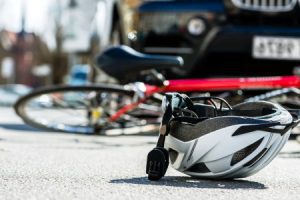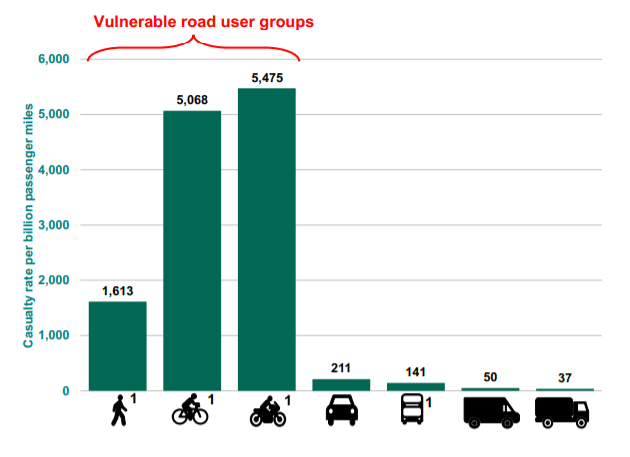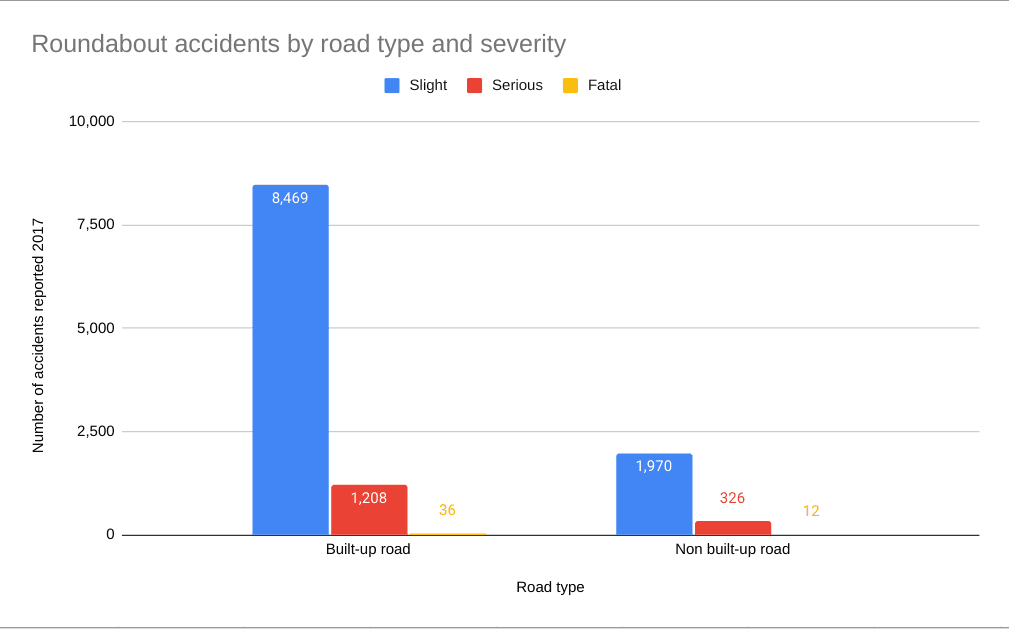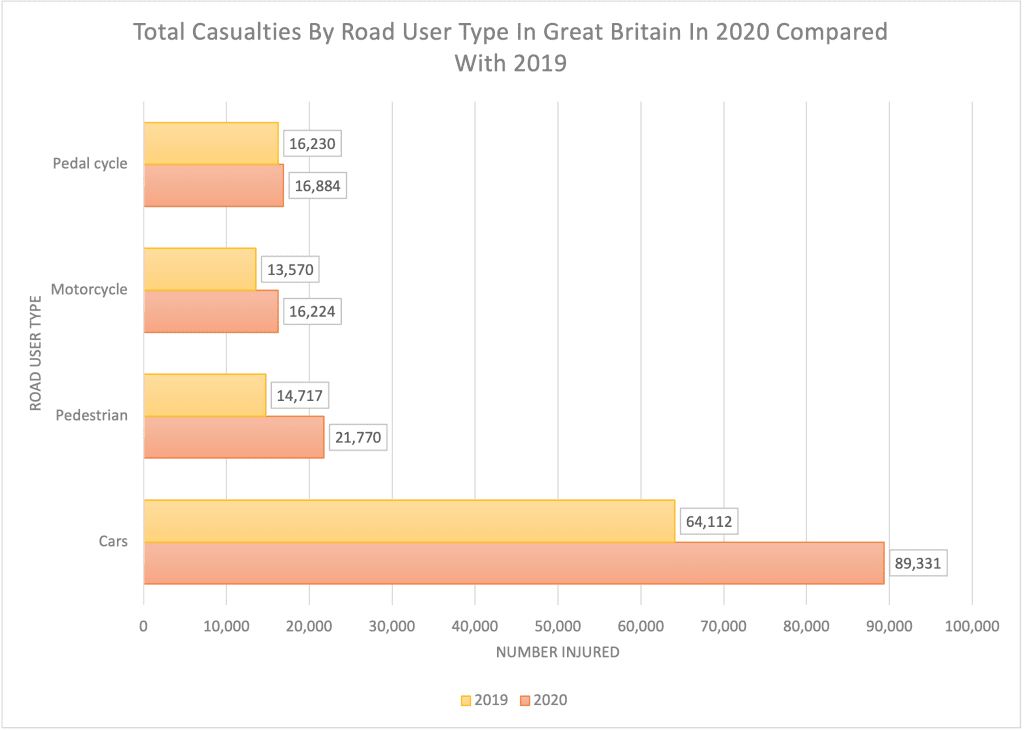By Joanne Jeffries. Last Updated 19th April 2022. Welcome to our guide on claiming after a cycle accident on a roundabout. Here, we’re going to look at the question, “There’s been a cycling accident on a roundabout; who is at fault?” We’ll also answer questions such as ‘Can cyclists go on roundabouts?’ explaining how to go around a roundabout on a bike according to the latest rules on cycling around roundabouts in the Highway Code. Determining roundabout accident liability is really important if you’re injured on a bicycle on a roundabout. That’s because if you can’t prove somebody else was to blame for the accident, you won’t be able to claim damages compensation.
I was injured on a bicycle on a roundabout – can I claim?

We’re going to look at the rules of navigating a roundabout on a bike, when a car driver might be to blame for a collision, and when you could be entitled to claim compensation. Finally, we’ll look at compensation amounts for different types of injury.
Accident Claims UK provides a personal injury claims service where you can receive free advice from our specialists. They’ll also offer a no-obligation assessment of your claim. If you decide to make a claim, and it’s found to be valid, you could be introduced to one of our No Win No Fee solicitors. If you’re already committed to starting a claim for a cycle accident on a roundabout, contact our advisers on 0800 073 8801 today.
Alternatively, to find out more information on who could be at fault in a roundabout accident, please continue reading.
Select A Section
- A Guide To Who Is At Fault For A Cycle Accident On A Roundabout
- What Is A Cycling Accident On A Roundabout?
- Cycling Road Traffic Accident Statistics
- The Highway Code For Cyclists And Roundabouts
- What Could Cause A Cycle Accident At A Roundabout?
- Who May Be At Fault If You Have A Cycle Accident At A Roundabout?
- What Should I Do If I Have A Cycle Accident At A Roundabout?
- What Happens If The Other Party Admits Liability?
- Cycle Accident On A Roundabout Compensation Claims Calculator – Updated October 2021
- Special Damages For Medical Costs And Other Expenses
- No Win No Fee Claims For A Cycle Accident On A Roundabout
- How To Make A Cycle Accident Claim For A Cycle Accident On A Roundabout
- Start Your Cycle Accident On A Roundabout Claim
- Further Guides Relating To A Cycle Accident On A Roundabout
A Guide To Who Is At Fault For A Cycle Accident On A Roundabout
Before looking at who is at fault for a cycling accident on a roundabout, we should inform you of the personal injury time limit associated with claims. In normal circumstances, this is 3 years from the date the accident took place. However, there are exceptions to this rule.
The other main criteria a solicitor would require that you demonstrate before they take on your claim are as follows:
- You had an accident while cycling on a roundabout.
- The incident was caused by another road user’s negligence.
- The incident left you injured.
Proving the first and last of the points above can be quite easy to prove by having witness statements and medical records. However, proving liability for a roundabout accident can be trickier. Therefore, we’ll advise what steps you can take to prove liability later in this guide. We’ll also look at the highway code for cyclists together with cycling accident statistics.
Accident when cycling around roundabouts? We could help
We have a team of solicitors who specialise in personal injury claims, including road traffic accidents. They have years of experience and the knowledge that could help you prove who was at fault for a cycle accident on a roundabout. Having a specialist on your side can make all the difference between winning the right level of compensation for your injuries or losing the case because you don’t have sufficient evidence to prove who was to blame.
When you’ve read through our guide, if you still have any unanswered questions, please contact our advisers. The advice we offer is free, and you’re under no obligation to proceed with a claim should you not wish to.
What is an example of a cycle accident on a roundabout?
A typical accident could see the cyclist be knocked off their bike by a car attempting to overtake them.
What Is A Cycling Accident On A Roundabout?
The purpose of this guide is to try and help you determine who could be at fault for a cycle accident on a roundabout. But what do we mean by ‘roundabout accident’? Well, in terms of personal injury claims, we’re talking about an accident where you, the cyclist, were injured following a collision with another vehicle while negotiating a roundabout. For your claim to be valid, you’ll need to be able to demonstrate that the accident was caused by the negligence of the other road user.
The types of accident where a driver could be to blame for an accident include where the driver is in the wrong lane and cuts across the roundabout to take an exit, or when they lose control due to excessive speed, or if they collide with a cyclist from behind. We’ll look in more detail at the types of potential accidents later in this guide.
Cycling Road Traffic Accident Statistics
Statistics from the Department of Transport show that cyclists, alongside pedestrians and motorcyclists, are more likely to be injured in road traffic accidents when looking at the casualty rate per billion miles travelled. However, the cycling accident on a roundabout accident rate for car drivers is much higher in general. The graph below displays the disproportionate number of casualties that affect vulnerable road users.

However, the statistics for fatality rates per billion miles travelled in the same year show that cycling crashes are less likely to result in fatalities; cyclists are killed at a rate of 29.4 per billion miles travelled, compared to motorcyclists at 113.3 fatalities per billion miles travelled, and pedestrians at 34.1 fatalities per billion miles.

The graph above shows the number of reports for a cycle accident on a roundabout, of any severity, on different road types in 2017. We can see that the road type with the lowest rate of accidents are motorways. The data released by the Department of Transport also included accidents that occured on motorways. However, as cyclists aren’t permitted on motorways, they wouldn’t be included in these accident numbers. We can see that accidents on roundabouts are far more likely to be slight than serious or fatal. It also indicates that the number of roundabout accidents on built-up roads far outstrips the number of roundabout crashes on non-built-up roads. You can see the road users injured on UK roads in 2020 by looking at the below statistics.

The Highway Code For Cyclists And Roundabouts
So, how do you know what lane to use as a cyclist on a roundabout? Well, the Highway Code has 6 rules providing advice on how to use a roundabout. Some of the rules contained in rules 184 to 190 of the Highway Code instruct you to:
- Give way to traffic coming from the right when entering a roundabout.
- Choose your exit quickly, use the correct lane and indicate before and when exiting.
- Be aware of other road users and remember that they might not be indicating correctly.
- Drive in the left-hand lane if exiting at the first exit.
- Approach in the right-hand lane if exiting to the right or going full circle.
- Use an appropriate lane for any intermediate exit and signal left when exiting.
- Be aware of traffic crossing in front of you and cyclists (who may stay in the left-hand lane regardless of which exit they’re using).
Can cyclists go on roundabouts?
For cyclists, there are 2 specific rules in the Highway Code, rules 76 and 77, which explain how to ride around a roundabout. Rule 76 actually tells the cyclist to refer to the general rules shown above (184 to 190). However, rule 77 does contain advice for cyclists, including:
- Be careful as drivers may not see you properly.
- When cycling across exits, take extra care. You might need to use right-hand turn hand signals to indicate that you’re not exiting.
- Watch out for other vehicles crossing your path that may be leaving or joining the roundabout.
The general advice is to stay in the left-hand lane if you feel it’s safe to do so. Alternatively, the advice says that you could walk your bike across crossings if you’re not confident cycling on a roundabout. Just be sure to collect all available evidence in the unwanted yet potential situation of a cycling accident on a roundabout.
What Could Cause A Cycle Accident At A Roundabout?
There are quite a few scenarios where an accident involving a cyclist could happen on a roundabout. Here are some of the more common:
- A motorist entering the roundabout without realising a cyclist is approaching.
- Motor vehicles cutting across the path of a cyclist to exit the roundabout.
- Vehicles changing lanes on a roundabout without noticing a cyclist in the space they’re entering.
Proving who is at fault for a cycle accident on a roundabout can be tricky and involve multiple vehicles. Therefore, we advise using a specialist solicitor who can review the evidence you provide and who has the ability to prove liability. In the next sections, we’ll look at who could be at fault and how you may be able to prove it.
Who May Be At Fault If You Have A Cycle Accident At A Roundabout?
When a cycling accident occurs on a roundabout, to make a claim, you need to be able to show who could be to blame. There are several potential scenarios, which includes the following:
- Another driver
- A combination of different drivers
- You (the cyclist) and the other driver
When the claim is caused by another driver or multiple drivers, your solicitor will use the evidence you provide to file a claim against them. In cases where you’re partially to blame for the accident, a claim could still be possible. Should this be the case, we recommend you discuss your case with a member of our team.
Consider a case where you were riding around the roundabout in the left lane. You intend to continue round the roundabout to the next exit but do not signal to the right. Another driver exists across your path because they believe you were exiting too. In this scenario, you could be partially to blame because of the lack of hand signals. The other driver could also be partially to blame because they didn’t give you enough space to continue round. Therefore, your solicitor and their insurer would work out what percentage of the blame applies to each party. Once decided, the compensation for a cycling accident on a roundabout would be calculated and then reduced accordingly.
What Should I Do If I Have A Cycle Accident At A Roundabout?
When claiming any type of road traffic accident, you’ll need evidence to support your case. It needs to show:
- What happened
- Who was to blame
- The injuries that you suffered
- Any costs you incurred
Therefore, if you’re involved in a cycling accident on a roundabout, you could take the following steps to try and prove what happened:
- Take photographs at the scene of the accident. If possible, do so before any vehicles have been moved from the scene.
- Record the details of all vehicles involved. This could include the make, model and colour of the vehicle. Also, record the licence plate number.
- Ask for the details of any driver involved. Ask for their name, address, contact number and insurance providers details. If you’re injured, and they fail to provide this information, they could be committing an offence under The Road Traffic Act 1988.
- Visit a GP or A&E for treatment. This will ensure your injuries are assessed and treated. Medical records from the appointment can be used to show the injuries you sustained and are essential when it comes to filing a personal injury claim against a negligent third party.
- Report the accident to the police. If somebody is injured, this should be done at the scene; otherwise, you can report the incident within 24-hours
- Ask any witnesses for their details. Also, if they have a dashcam fitted to their vehicle, ask to be sent a copy of the footage.
While this can seem time-consuming, the more evidence you have, the easier your solicitor will find it piecing together the chain of events that led to the cycle accident on a roundabout, and the stronger your case would be.
What Happens If The Other Party Admits Liability?
While you’re at the scene of the accident, if another driver accepts the blame, you should still gather as much evidence as possible. That’s because it’s not unheard of for people to change their minds and deny liability when contacted by your solicitor. However, if the other driver’s solicitor accepts liability on their behalf, the claims process can move on to the settlement phase.
When a solicitor accepts liability, it could be in any of the following ways:
- Accept full responsibility. This means they agree their client was to blame for the accident and the injuries claimed for
- Admitting liability except for causation. This means that the other driver has agreed that they are to blame for the accident. However, they aren’t admitting the blame for your injuries. This isn’t unusual. It just means that their insurer wants medical evidence to prove that the injuries were a) real and b) caused by the accident and not in some other way.
- Accepting partial liability. In this scenario, the other party admits being to blame and alleges that you’re also partially to blame. This can be contested between both parties until an agreement is made on the different levels of blame. An example being the driver was 75% to blame, and you were 25%. Compensation for the cycling accident on a roundabout is then awarded accordingly.
Cycle Accident On A Roundabout Compensation Claims Calculator – Updated October 2021
You might want to know how much compensation you could receive following a roundabout collision if your claim is successful. While it’s not possible to say definitively how much compensation you could be awarded, as every case is unique, we have provided the personal injury claims compensation table below. It shows figures that courts, insurers and solicitors use when calculating compensation figures based on the Judicial College Guidelines.
| Injury | How Severe? | Compensation | Notes |
|---|---|---|---|
| Neck Injury | Severe | £42,680 to £52,420 | Injuries where fractures, dislocations or ruptured tendons lead to permanent and chronic disabilities. |
| Neck Injury | Minor | £2,300 to £4,080 | Soft tissue injuries of the neck which recover fully, without surgery, within three months to a year. |
| Back Injury | Severe | £36,390 to £65,440 | Disc lesions, disc fractures or soft tissue damage that lead to chronic conditions leave disabilities despite treatment. |
| Back Injury | Minor | Up to £2,300 | Soft tissue injuries of the back where complete and full recovery happens within 3 months. |
| Arm Injury | Simple Fracture | £6,190 to £18,020 | This compensation range covers simple forearm fractures. |
| Elbow Injury | Severe | £36,770 to £51,460 | This category includes severley disabling injury to the elbow. |
| Elbow Injury | Less Severe | £14,690 to £30,050 | Those injuries which cause impaired function but don’t require major surgery or result in significant disability. |
| Wrist Injury | Fracture | In the region of £6,970 | An uncomplicated Colles’ fracture of the wrist would fit into this category. |
| Leg Injury | Very Serious | £51,460 to £85,600 | Injuries which mean the claimant requires the permanent use of crutches for the rest of their life. |
| Ankle Injury | Severe | £29,380 to £46,980 | Fractures or other ankle injuries where pins and plates are needed to stablise the injury. There will be significant residual disabilities. |
Importantly, the figures are based on the severity of your injuries. Therefore, to ensure you receive a fair amount of compensation, your solicitor would need to prove the exact nature of your suffering. Our solicitors use independent doctors to assess your injuries, and they produce a medical report which shows what injuries were initially sustained, the impact they caused and what long-term effects, if any, there might be.
To find out what else can be included in your compensation after a cycling accident on a roundabout, read on to our next section.
Special Damages For Medical Costs And Other Expenses
When your solicitor sits down to calculate the compensation they’ll ask for, they look at two things, namely general damages and special damages. General damages are awarded to compensate an injured party for the pain and suffering suffered. The table in the previous section provides general damages amounts for various injuries.
Special damages, however, are awarded for financial losses linked to your collision on a roundabout. Many elements can make up a special damages claim. They can include:
- Care costs
If you need support while recovering from your injuries, you could claim back the cost of a carer. This could be a professional carer’s fees, or it could also include the time of a family member who cared for you. - Medical costs
The cost of any treatment you’ll receive will usually be free on the NHS. However, the costs of other medical care, over the counter medicines, and prescription costs for some, can soon add up and would not be covered by the NHS. Therefore, these could be included. - Travelling expenses
If you need to travel to and from the hospital or GP appointments, you could claim back the fuel costs and any car parking fees. - Lost income
Some people don’t get paid full sick pay when taking time off work for medical appointments or to recover. If that’s the case, you could claim back any loss of earnings. If your injuries are going to affect your work capacity long-term, you could claim for future lost income too. - Damaged property
Finally, if any item of your personal property is damaged in an accident on a roundabout, you could claim for replacing or repairing the item. This might include the bike, your helmet or clothing.
To aid your solicitor, you should retain any receipts and other relevant documents that are linked to items you’re going to claim as special damages.
No Win No Fee Claims For A Cycle Accident On A Roundabout
When you’ve worked out who is at fault for a cycling accident on a roundabout and decided to make a claim, you might worry about the cost of hiring a personal injury lawyer to represent you.
Our solicitors work on a No Win No Fee basis for cases they take on. This means more people can claim compensation for injuries sustained without worrying about the financial cost.
To work on this basis, a personal injury solicitor would need to check your claim is valid. Once they’ve done so, if they agree to take on your claim, they’ll give you a Conditional Fee Agreement to sign (CFA). The CFA explains that there are no solicitor’s fees payable unless you receive compensation. It also explains the success fee you’ll pay when your case is won.
The success fee is used to pay the solicitor’s fees. It’s a percentage of your compensation that’s deducted before the remainder of the settlement is sent to you.
If you’d like us to check whether you can claim your cycle accident on a roundabout on a No Win No Fee basis, call an adviser today.
How To Make A Cycle Accident Claim For A Cycle Accident On A Roundabout
Now that you’ve read about claiming a cyclist accident at a roundabout, you might want to know why we think you should use Accident Claims UK. Here are some reasons:
- You can contact us 24-hours a day, 7-days a week.
- The advice provided by our advisers is free of charge.
- We offer a no-obligation assessment of your claim.
- Our team of solicitors have been working on personal injury claims for up to 30 years.
- Our solicitors always try to work as swiftly as possible, so they don’t cause any delays.
- Finally, our solicitors will always try and ensure you receive the correct level of compensation. They’ll do so by presenting as much evidence as possible to show the true level of suffering caused by your cycling accident.
If there’s any more information you need about how we could help you claim, please get in touch today.
Start Your Cycle Accident On A Roundabout Claim
Hopefully, you now know who could be at fault for a cycle accident on a roundabout. If you believe somebody else was to blame for your accident and injuries, we hope you’d like to use Accident Claims UK to make your claim. If so, you can contact us by any of the following routes:
- Call and speak with a specialist adviser on 0800 073 8801
- Email details of your cycling accident on a roundabout to office@accidentclaims.co.uk
- Use our live chat feature to connect directly to an adviser.
- Start your claim online by using our online claims form.
When you get in touch, our advisers will begin by assessing your evidence in a no-obligation assessment. They’ll then provide you with free legal advice about your options. If they believe your personal injury claim is winnable, they could introduce you to one of our solicitors. If they take on your claim, it’ll be on a No Win No Fee basis.
Further Guides Relating To A Cycle Accident On A Roundabout
To assist you further, we’ve linked to some more of our relevant guides:
Roundabout Accident Claims – If you’re a cyclist hit by a car at a roundabout, this is another guide that might prove helpful.
Cycling Accident Claims – In this guide, you’ll find information on how a personal injury solicitor could help a cyclist hit by a car claim compensation.
Road Traffic Accident Claims – This guide looks at all sorts of personal injury claims for injuries sustained in RTAs.
Cycling Road Safety Resources
Finally, here are some cycling safety resources which you might find useful:
Government advice on cycling safety – Guidance on how to use the road safely as a cyclist.
The Highway Code For Cyclists – Sections 59 to 82 of the Highway Code provide the rules for cyclists.
Cycle Accident On A Roundabout FAQs
Who has the right of way at a roundabout?
Unless road signs/road markings indicate otherwise, the driver on the right as you approach a roundabout has the right of way.
Who is at fault in a roundabout accident?
This is the person who may be trying to enter the roundabout or trying to overtake another driver on the roundabout.
How do I claim after a cycle accident?
You should get medical attention, note the car’s registration number, report the accident as soon as possible and contact a solicitor.
What happens if a cyclist hits you?
You should stop and check that the cyclist is okay.
Do you have to report hitting a cyclist?
Yes, you should report the incident as soon as possible, as well as calling an ambulance for the victim.
What is the 12 o’clock rule?
This is where you should stay in the left-hand lane if you’re planning to turn left on a roundabout where the main exit is directly ahead as you enter it.
When should you signal on a roundabout?
This should happen as soon as possible when you plan to turn and with you checking your mirrors beforehand.
Can you enter a roundabout if the exit is blocked?
It’s advisable not to do so and to also not block traffic from entering a roundabout that you’re already on.
Should I use a local solicitor to help me with a claim for a cycle accident on a roundabout?
If you’re looking for a solicitor to help you make a claim for compensation for a cycle accident involving a roundabout, you might assume you need to use someone local. However, there are many law firms and solicitors based all across the UK who could help you with your claim. When you look for a solicitor to help you, it might be worth choosing one that is authorised and regulated by the Solicitors Regulation Authority and that works on a no win no fee basis. Other ways in which you could investigate the solicitor would be to look into their success rate and take a look at some reviews that previous claimants have left them. Investigating the solicitor before you go ahead and use their services could give you peace of mind that your claim is in the right hands.
How is cycle accident compensation calculated?
If you’re looking to claim compensation for your injuries, you might want to also consider the fact that you might have incurred losses or expenses due to your cycle accident. All of these could be calculated as part of your claim and included as special damages. This is alongside the general damages you could receive for the suffering and pain you experienced from your injuries. If you would like to speak to us about the type of compensation you could be eligible for, please call our team.
Updated Highway Code Rules On Cycling Around Roundabouts – 2022
According to the updated Highway Code, which came into force in January 2022, motorists should take care to reduce the risk of vulnerable road users. There is a new rule for motorists that find themselves near a cyclist on a roundabout. Drivers must give cyclists priority on roundabouts. Rule 186 states that drivers need to give those cycling around roundabouts plenty of room. They must also ensure not to cut across their path or overtake them within the space of their lane.
How to go around a roundabout on a bike according to the updated Highway Code
The Highway Code says that cyclists could stay in the left lane if they intend on continuing across the roundabout or around it. They must, however, signal to the right to ensure drivers are aware they’re not leaving the roundabout.
What about drivers entering when there is a bicycle on a roundabout?
Drivers entering when there is a bicycle on a roundabout should take extra care not to cut across cyclists in the left lane on entry.
Can cyclists go on roundabouts?
Cyclists can go on roundabouts. However, if there is a cycle path around a roundabout, they would likely be safest cycling on that path.
I was injured cycling around roundabouts – can you help me?
If you were injured due to another road user’s negligent breach of their duty of care towards you as a cyclist on a roundabout, we could help. We could assess your eligibility to claim compensation. We could also help you begin your claim.
Thank you for reading our guide on making a claim following a cycle accident on a roundabout. We hope you have learned a lot about making a claim for a cycling accident on a roundabout.



